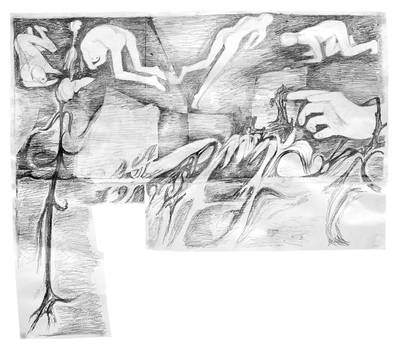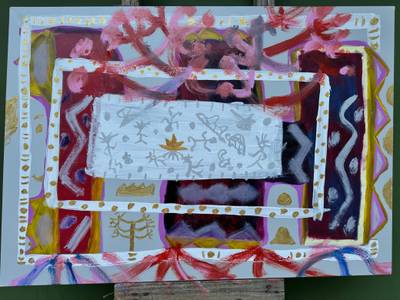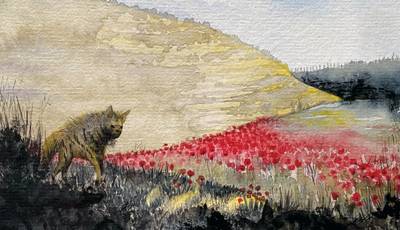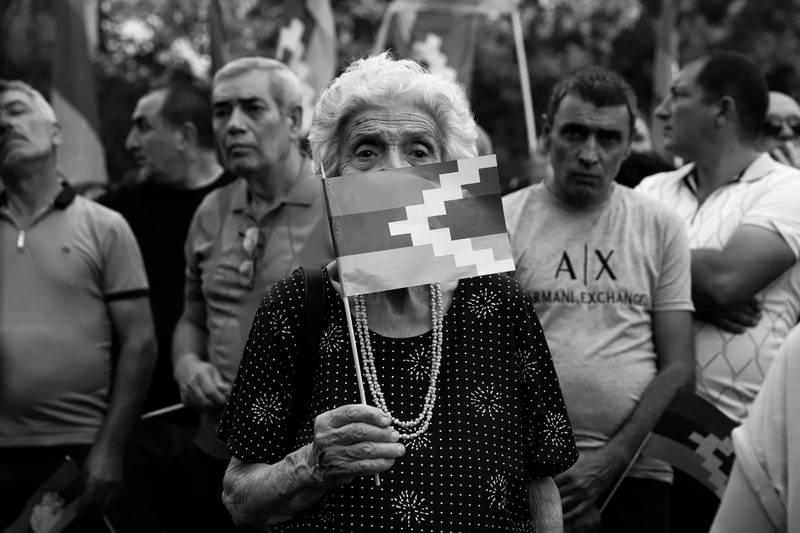

Photo by Gayané Ghazaryan
Gayané Ghazaryan is a documentary photographer and independent journalist based in Yerevan, Armenia. Drawing on oral history methodology and visual storytelling, her work primarily explores issues related to young people and the working-class in Armenia – from post-war realities in border villages to the impact of environmental destruction on local communities.
I tend to think of my life as an Armenian in two periods: before September 27, 2020, and afterwards. My generation grew up with the history of the Armenian Genocide and several pogroms of Armenians in azerbaijan. The narratives of my paternal ancestors fleeing Mush2 and my maternal lineage being uprooted from their native village of Vardashen, now under azerbaijani control, were part of my upbringing. Growing up, these stories seemed distant—something you could only encounter in history textbooks. While I acknowledged their weight and importance, I never fathomed that my generation, the independence generation, would face the same atrocities during our lifetime. History seems cyclical because the structures that produce systemic violence remain, regardless of the number of decades or centuries gone by. Being an Armenian post-2020 feels like a series of violent Septembers that stir ancestral trauma and deepen our collective open wounds.
How can you claim the land as yours and then burn it with chemicals? Apparently, that’s what settler-colonies like azerbaijan and israel do. It’s worth noting that israel has been azerbaijan’s main supplier of arms too.
September 2020
The photo on my lock screen is a self-portrait of my brother’s childhood friend, Arman, who grew up as a younger brother to us. When I put our photo on my screen, I said to myself, “I’ll change it when he returns home.” He never did.
On the morning of September 27, we woke up to the news of a large-scale offensive against Artsakh (Nagorno-Karabakh)3 by azerbaijan, what came to be known as the Second Artsakh war or the 44-Day war. Days turned into weeks, and war permeated almost every Armenian home. The crisp autumn air was filled with heavy grief. With over 5000 people killed, most of them 18-20-year-olds, one could rarely meet someone who hadn’t lost anyone to azerbaijani aggression, including our brothers from the Kurdish, Yezidi and Assyrian communities. Dozens of Armenians were taken as prisoners of war, and hundreds are still missing, including my dear friend.
The invaders killed our people and the land. Among the countless war crimes azerbaijan committed over the course of 44 days was the use of white phosphorus to burn the forests of Artsakh as civilians were hiding there. Roughly 1815 hectares of forest area was destroyed, leaving the soil intoxicated and uninhabitable for wildlife. How can you claim the land as yours and then burn it with chemicals? Apparently, that’s what settler-colonies like azerbaijan and israel do. It’s worth noting that israel has been azerbaijan’s main supplier of arms too.
While azerbaijan was bombing Armenians with israeli and turkish UAVs and paying bonuses to turkish-backed Syrian mercenaries for beheading Armenians, the “international community,” whatever that’s supposed to mean at this point, expressed lousy words of “concern,” and displayed a nauseous stance of both-sideism, devoid of any tangible action. The existence of this unrecognised republic and its indigenous population wasn’t legitimate enough for world powers to lift a finger. The Second Artsakh war resulted in the handover of almost 70% of Artsakh to azerbaijan, leaving more than 70,000 indigenous Armenians internally displaced and marking the beginning of a slow genocide by azerbaijan.
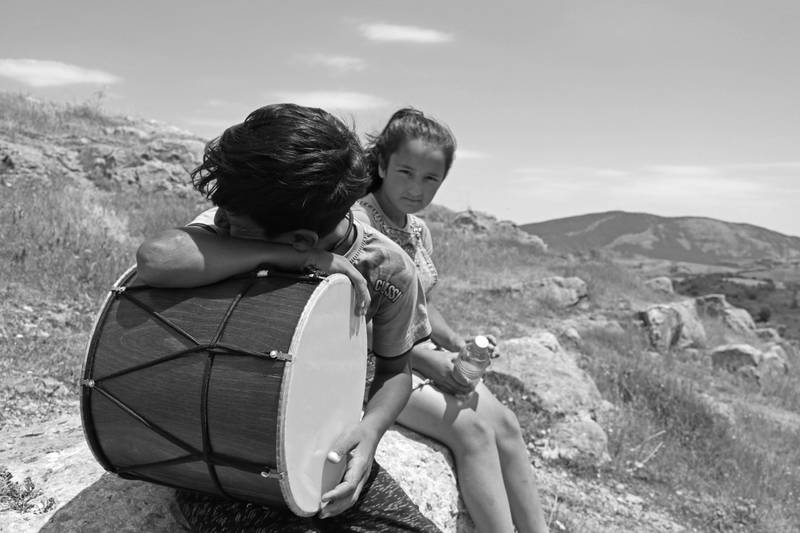

Children having a rest after playing music at Jdrduz canyon near Shushi, Artsakh. 2019. The region was occupied by azerbaijan in 2020.
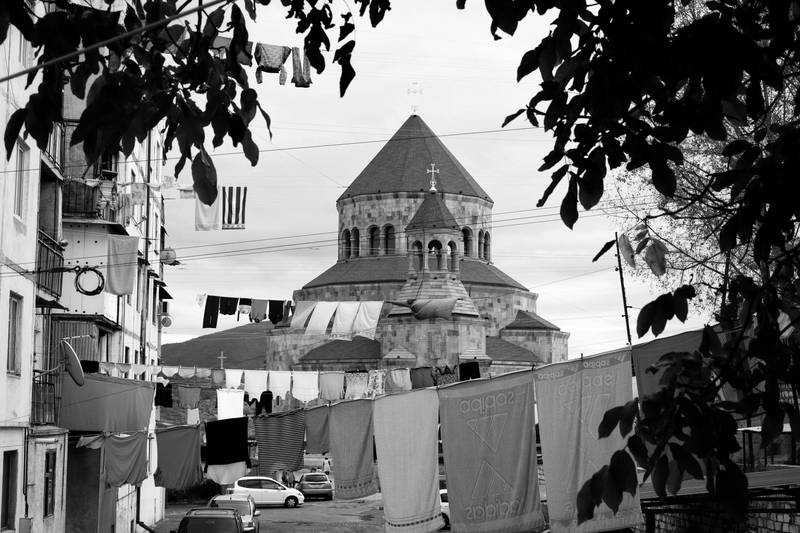

Lines of laundry in one of Stepanakert’s neighborhoods with the Holy Mother of God Cathedral in the background. 2019
September 2022
It was my first post-war trip to Artsakh, and, unfortunately, the last one. I was headed to the capital, Stepanakert, to teach photography workshops to teens and work on my oral history project, collecting the life stories of displaced women. The road to Artsakh was one humiliating, gut-wrenching experience, where the presence of occupiers was a stark reminder of the ongoing dispossession of our people. In the aftermath of azerbaijan’s claim to most of Artsakh in 2020, the only lifeline connecting Artsakh to Armenia, and thereby the rest of the world, was the Berdzor (Lachin) corridor with its multiple checkpoints. At every checkpoint, we had to display our passports to Russian peacekeepers who were there “to assure the safety of Armenians,” while there were azerbaijani and turkish flags fluttering in the distance. Having to show my passport to a Russian soldier was humiliating on its own, and seeing the flags of our colonisers4 rising up on our mountains that generation after generation had to fight for felt like a dystopian nightmare come true. My brain couldn’t come to terms with what my body experienced. “Why do I have to get permission from a Russian soldier to move freely in my people’s land?” constantly echoed in my head.
My anger and distress were somewhat ameliorated by the perseverance of our people, especially women. I met women who had lost their sons to the war. Women who had left their homes, memories and graves of their loved ones behind. I met women who’d seen the mutilated bodies of their relatives. These were also the women who possessed a feeling of gratitude and hope that someday they’ll return home.
Within months after the so-called “peace agreement,”5 azerbaijan embarked on a campaign of cultural erasure and territorial reshaping, building settlements with huge entrance plaques written in the azerbaijani script. There were azeri construction workers at various points along the road. I caught myself almost in envy, feeling disdain for our own government — former and current — whose neoliberal politics had left the country without proper infrastructure or public services, instead feeding the bank accounts of oligarchs and political elites (who, in many cases, were the same people). Guilty of my own thoughts, I was reminded of “Returning to Haifa” and Ghassan Kanafani’s poignant portrayal of post-occupation dynamics. “This is part of the war. They’re saying to us, ‘Help yourselves, look and see how much better we are than you, how much more developed. You should accept being our servants. You should admire us,’” Said told his wife at the entrance to the city for the first time after occupation (Palestine’s Children, 2000).6 I knew rural communities in azerbaijan were affected by post-Soviet greed and corruption as much as we were and that their rural communities, in spite of oil profits, were still underdeveloped while the triumphant dictator flaunted oil wealth in occupied Artsakh.
My anger and distress were somewhat ameliorated by the perseverance of our people, especially women. I met women who had lost their sons to the war. Women who had left their homes, memories and graves of their loved ones behind. I met women who’d seen the mutilated bodies of their relatives. These were also the women who possessed a feeling of gratitude and hope that someday they’ll return home. Among them was Hratsin, a native of Artsakh’s Hadrut region. Hratsin’s life story is a reflection of Artsakh’s decades-long fight for self-determination and the tragic losses that came with it. Hratsin’s childhood was marked by the hardships of the first Karabakh war. The April war of 2016 took away her father. She lost her native Hadrut in the 2020 Artsakh war, and the 2023 September war made her a refugee with no prospects of returning home in the foreseeable future. Despite this, she had a resilient outlook towards the future. “I don’t fear the future. I keep on living as I used to. No matter where you are, you will still keep on living. I only wish for peace so our youth won’t have to get martyred. It has been enough.” (Hratsin Ohanyan, personal communication, September 2022)
But peace is a privilege. azerbaijan’s next attack didn’t take long. On September 13, 2022, it launched a large-scale assault on Armenia proper, fueling anxiety in Artsakh. The air in Stepanakert was tense those days. During the day, there was a suffocating silence, as if everyone was waiting for the worst to come, glued to our phones for updates. Dozens of people would gather downtown every evening to collectively discuss and dare to imagine the future. Self-determination was at the core of those rallies.
Meanwhile, we would wander the streets of Stepanakert with my students, observing the reality through the viewfinder. They’d capture the fresh laundry drying in the sun, their favourite hang-out point known as “Pitachok”, and the kind-hearted grandpas hanging out near the fountains. While checking their camera exposure and giving composition advice, I would keep praying in my head that those teens would never hear another sound of shelling or be forced to leave their beloved town. Unlike me, they were more courageous—brave enough to dream and tie their futures to Artsakh despite the looming danger of yet another invasion.
Every news story of azerbaijani invasion has always been followed by images of horrendous war crimes the azeri soldiers proudly share on social media platforms with zero punishment. Point-blank execution of Armenian soldiers and civilians, rape, torture, and mutilated bodies; how much can one consume all that cruelty? On September 16, I woke up to the news of Anush Apetyan’s murder, a female Armenian soldier whose body was grotesquely mutilated by azerbaijani soldiers. “Her body had been stripped naked with text written across her breasts and stomach. A stone has been placed in her eye socket and a severed finger in her mouth” (OC Media, 2022). My roommate/colleague and I walked all the way to work in complete silence that day. We didn’t discuss what we had read and seen—we knew it. It was unbearable. Impossible to ever process.
The mutilation of murdered Armenian bodies was a recurring phenomenon in the stories of the women I interviewed, too. Nairuhi Tovmasyan, who had been forcibly displaced from the village of Karin Tak (Shushi region), recalled in-detail the tragic story of her sister-in-law, whose remains were found 70 days after her murder. “My husband’s sister was dismembered when the azerbaijani soldiers captured the village. They had entered the house in two groups. The first one killed and dismembered her. And the second buried her under the pile of onions” (Tovmasyan, personal communication, September 25, 2022).
I left Artsakh with a heavy heart but determined to return in December. That trip never turned into reality. In mid-December, a group of azerbaijani so-called “climate activists” blocked the Berdzor corridor. Within weeks, a fabricated climate protest was followed by an illegally-installed checkpoint by azerbaijan marking the beginning of what would become the complete siege of Artsakh, where even the Red Cross, the only international humanitarian organisation operating in Artsakh at the time, was not allowed in.
For months, people grappled with extreme food and fuel shortages, with little electricity and no gas at all. Pregnant women experienced misscarriage due to malnourishment, as by summer, finding a loaf of bread felt like a miracle. Despite the horrible conditions azerbaijan created thanks to the inaction of Russian “peacekeepers,” people were determined to stay in Artsakh. “Sometimes when I complain about walking for an hour in the burning sun and then waiting for a couple of more hours to get two loaves of bread, I remind myself that it could be much worse—at some point, maybe we won’t even be allowed to live here, and I will be in a different place longing for these days, just to be in my city.”7 These were the words of one of my students, whose fear, unfortunately, turned into reality.
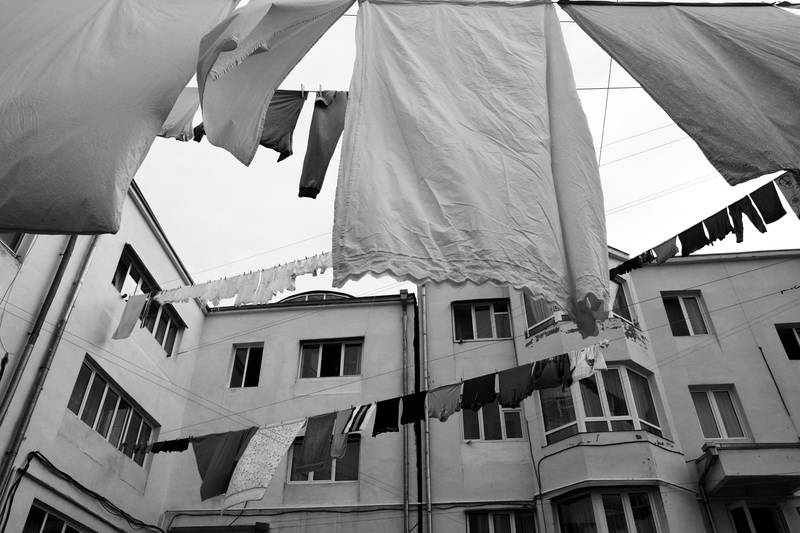

Fresh laundry in one of capital Stepanakert’s neighborhoods. 2022.
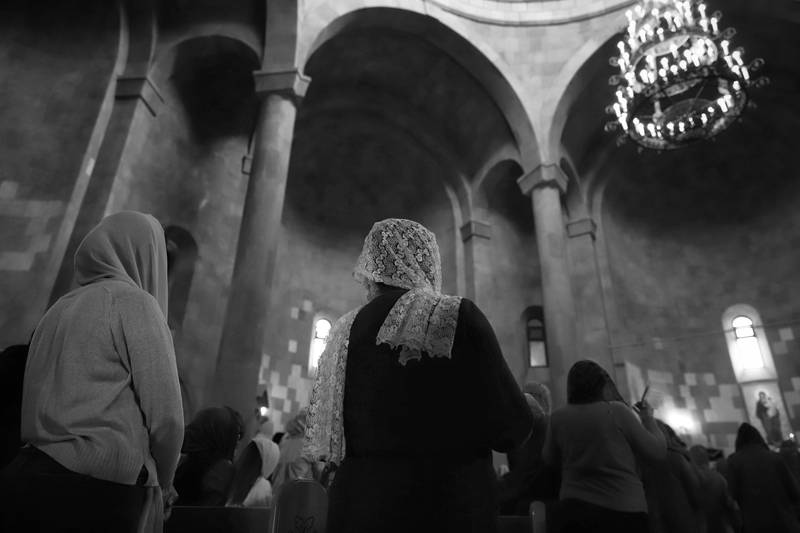

A woman praying at the Holy Mother of God Cathedral, Stepanakert, Artsakh. 2022
September 2023
Unable to force Armenians out of their lands by starvation, azerbaijan moved to the final step of ethnically cleansing Artsakh. On September 19, it launched an “anti-terror” offensive on the starved population it claimed to be its citizens. Isn’t it ironic how states whose entire existence is an act of terror label the colonised as “terrorists” to justify their aggression? For years, high-ranking azerbaijani officials have been dehumanising Armenians, from calling us “dogs” to comparing us to a virus that needs to be purged. As Frantz Fanon described in his Wretched of The Earth (1961)8, “In fact, the terms the settler uses when he mentions the native are zoological terms.”
Within days, families—starved, bombed, and dispossessed—packed whatever they were able to fit in their cars and lined a serpentine road to Kornidzor village in Armenia’s Syunik province. And those who didn’t possess cars were squeezed on the backs of big trucks, with at least fifteen-twenty people on each. Normally, it would take a maximum of three-four hours to get from Artsakh to Armenia, but this time people had to wait for over twenty hours to cross the same road. Later, reports emerged that over 50 people had died on the road, and many were psychologically abused by azerbaijani soldiers.
I despised how (mostly) foreign journalists—no matter their intentions and backgrounds—“jumped” on the vehicles transporting displaced families just to get "emotional footage,” or a quick answer to their questions, which, unsurprisingly, was often informed by the reporter’s own biases, nationality or lack of proper understanding of my country, its people and even the occupiers.
I was in Kornidzor working as a fixer for a French TV channel as hundreds of Artsakh Armenians arrived every hour. The reporter I was translating for would approach the cars of displaced Armenians and film them. Most families crossing into Kornidzor hadn’t had a warm meal in months. Sleep-deprived, many lacked the physical and emotional capacity to even answer simple questions. There were numerous local and international media outlets in Syunik in those days. While I was glad the situation was finally being covered, I once again caught myself rethinking the intent and methodologies used to do it. I hated how they wouldn’t slow down. How they’d disregard the emotional wellness of a human being traumatised beyond words just to get what they want—to steal their words and tears for a “compelling story,” while many of the outlets they work for weren’t interested in covering the nine-month blockade that resulted in the malnourishment, death and loss of unborn babies.
I despised how (mostly) foreign journalists—no matter their intentions and backgrounds—“jumped” on the vehicles transporting displaced families just to get "emotional footage,” or a quick answer to their questions, which, unsurprisingly, was often informed by the reporter’s own biases, nationality or lack of proper understanding of my country, its people and even the occupiers. The reporter I was working with would keep stressing that one of the contributing factors to the “conflict” was the fact that Armenians are Christian and azerbaijanis - Muslim. When I confronted him, saying that this has nothing to do with religion and everything with azerbaijani nationalism and capitalist interests, his excuse was that “one of the reasons the French sympathise with Armenians is the religion.” To me, it didn’t really speak of their humanity towards a Christian population, but was rather a reflection of France’s islamophobic tendencies.
By January 1st, “The Republic of Artsakh will cease to exist”9 (Shahramanyan, 2023). That’s a politically polite way of saying Artsakh has been completely occupied. Meanwhile, Artsakh’s landscapes are devoid of its people for the first time in millennia, with over 120,000 internally displaced indigenous Armenians now scattered across Armenia, grieving the loss of their loved ones, their homes, their mountains and their forests. As we collectively continue to process and grieve the occupation of yet another part of our ancestral homeland and the erasure of cultural identity, we wake up to new threats of war10 and annihilation by the EU’s “trustworthy” partner, azerbaijan.
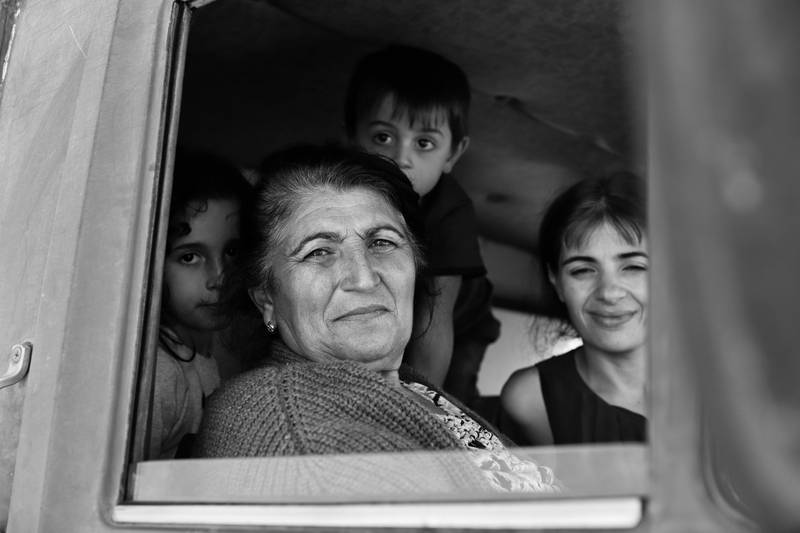

A group of displaced people entering Armenia who had to flee their homes as a result of azerbaijan’s large-scale attack that started on September 19, 2023. Syunik, Armenia. 2023
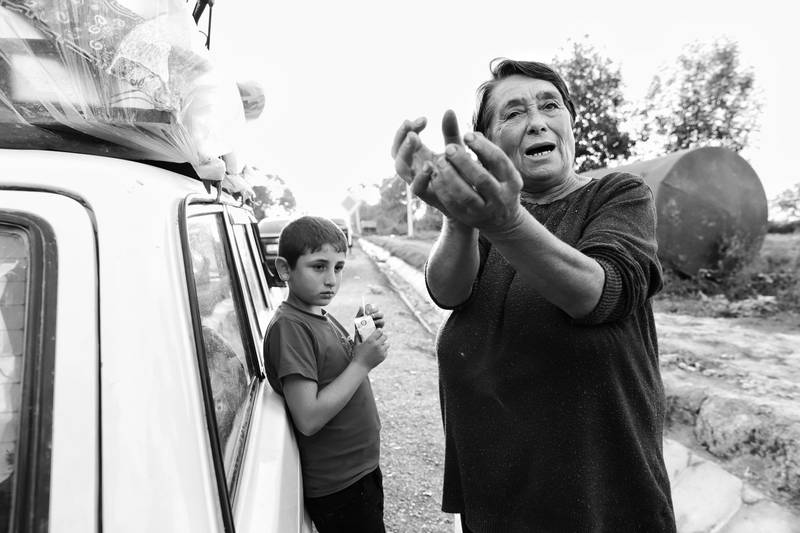

Elmira, 63 and her grandson, who had to flee their home in Artsakh’s Martuni region due to azerbaijani aggression. Syunik, Armenia. 2023
